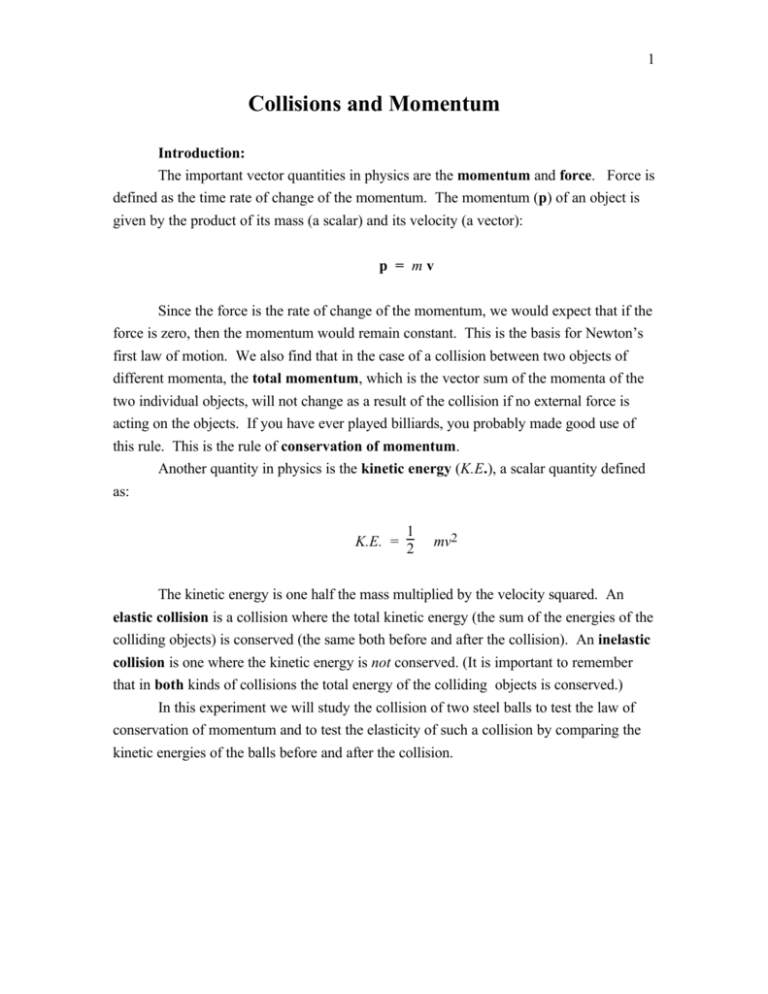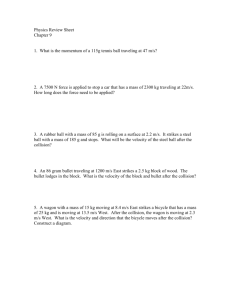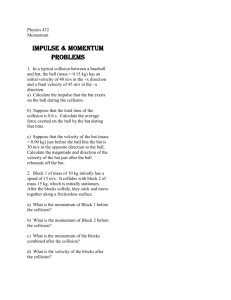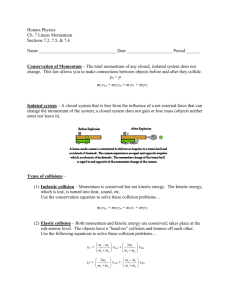Collisions and Momentum
advertisement

1 Collisions and Momentum Introduction: The important vector quantities in physics are the momentum and force. Force is defined as the time rate of change of the momentum. The momentum (p) of an object is given by the product of its mass (a scalar) and its velocity (a vector): p = mv Since the force is the rate of change of the momentum, we would expect that if the force is zero, then the momentum would remain constant. This is the basis for Newton’s first law of motion. We also find that in the case of a collision between two objects of different momenta, the total momentum, which is the vector sum of the momenta of the two individual objects, will not change as a result of the collision if no external force is acting on the objects. If you have ever played billiards, you probably made good use of this rule. This is the rule of conservation of momentum. Another quantity in physics is the kinetic energy (K.E.), a scalar quantity defined as: 1 K.E. = 2 mv2 The kinetic energy is one half the mass multiplied by the velocity squared. An elastic collision is a collision where the total kinetic energy (the sum of the energies of the colliding objects) is conserved (the same both before and after the collision). An inelastic collision is one where the kinetic energy is not conserved. (It is important to remember that in both kinds of collisions the total energy of the colliding objects is conserved.) In this experiment we will study the collision of two steel balls to test the law of conservation of momentum and to test the elasticity of such a collision by comparing the kinetic energies of the balls before and after the collision. 2 Theory: v v vy h R The above diagram depicts the apparatus which we will be using. After rolling down a ramp, a steel ball leaves the ramp with a horizontal velocity v. At any point in the trajectory of this ball, the horizontal component of this velocity will remain constant if air friction is negligible. The vertical y-component of the velocity will increase according to the acceleration due to gravity (g); its initial value is zero. The ball strikes the floor after traveling a horizontal distance R (range) and vertical distance h (height). Under these conditions, we can employ the equations for free-fall motion under constant acceleration to determine the time of flight t, and the initial horizontal velocity v. gt2 h = 2 R = vt Solving the left equation for t and substituting it in the right equation yields: 1 R2 h=2 g 2 v On solving this last equation for v , one obtains: g v = R 2h 3 Because g and h are the same for all balls used, we see that the initial horizontal velocity is directly proportional to the range. Due to this proportionality, the range is an indirect measure of the velocity. If velocity is in any horizontal direction, the above relation will hold true. Therefore, for collisions which occur at the bottom of the ramp, the distance and direction the balls travel after the collision can be used to determine their velocities after the collision. Vector analysis of the two-object collision: In our experiment we will be investigating a case where a steel ball at rest at the bottom of the ramp is struck by another ball of equal mass rolling down the ramp. The momentum conservation describing this collision is as follows: or p1 = p1' + p2' mv1 = mv1' + mv2' (1) The momentum p1 is the momentum of the ball which rolls down the ramp before the collision, and p1' and p2' are the momenta of the balls immediately after the collision. We see from the second equation that in the case when the masses are equal, we can divide the equation through by the mass, yielding an equation relating the vectors for the horizontal velocities: v1 = v1' + v2' (2) We have also seen in the case of negligible air friction that these velocities are proportional to and in the same directions as the horizontal displacements of the balls, so that: r1 = r1' + r2' (3) The following drawing illustrates the case where a single ball is allowed to fall off the ramp without a collision, yielding the initial displacement vector r1 (proportional to the initial velocity). The drawing also contains the case of the collision. 4 r1 r1 r2' r1' no collision collision In the case of an elastic collision, the kinetic energy before and after the collision is conserved: 1 2 1 mv1 2 = 2 1 mv1' 2 + 2 mv2' 2 (4) and since the masses are all equal, and since the velocities are proportional to the ranges: r1 2 = r1' 2 + r2' 2 (5) where r1, r1', and r2' are the lengths of the displacement vectors depicted above. Since these three vectors form a triangle (from conservation of momentum), and since the last equation is identical in form to the Pythagorean theorem, r1' and r2' are at a 90° angle to one another in an elastic collision. Procedure: 1. Make sure that the two balls have practically the same mass. 2. Secure the ramp to the table using a c-clamp. The end of the ramp should be level to make the initial velocity in the horizontal direction. You can place paper under the ramp to accomplish this. 3. Place a large piece of marking paper on the floor and secure it with masking tape. One of the short sides of the paper should be directly under the ramp. 4. Move the target support screw aside so it will not interfere with the ball leaving the ramp. Use the plumb bob to locate the point directly under the exit point of the ball. Mark this point as "O". This will be the starting point of the displacement vector r1. 5. Place a large sheet of carbon paper on the large sheet and allow the ball to roll down the ramp and strike the carbon a few times. Make sure the initial height of the ball on the ramp remains the same on each trial and that its initial velocity on the ramp is zero. 5 6. Estimate the average point for the cluster of points on the large sheet and label it as "C". The range vector "OC" represents the momentum vector p1, the momentum of the first ball before all subsequent collisions. 7. Place the support screw so that it will support the target ball at an angle of about 30° to the path of the vector "OC". 8. Put the second steel ball of identical mass on the support screw. Use the plumb bob to find the position on the marking paper directly under the second ball in its initial position. Mark this point as "T". 9. With the carbon paper in place, allow the first ball to roll down the ramp in a manner described above, colliding with the target ball. Repeat several times. 10. Remove the carbon paper. And record the landing points of the two balls as "A" for the first ball and "B" for the second. The vector "OA" represents the momentum p1', the momentum of the first ball after the collision. The vector "TB" represents p2', the momentum of the target ball after the collision. Analysis: 1. Measure and record on lab form the lengths of "OC" and "OA" and "TB". These lengths are proportional to the velocities v1, v1' and v2'. 2. Check if the equation is elastic using the equation in the theory section. 3. Use a protractor and a meter-stick to investigate whether the sum of vectors "OA" and "TB" equals "OC". To accomplish this you will need to translate either "OA" or "TB". 4. Your marking sheets should be turned in with your labs. Conclusions: 1. Write about your results in this experiment. 2. Was the momentum conserved? Explain your answer. 3. Was the kinetic energy conserved? If the K.E. was not conserved, where was energy lost? 4. What effect would having the balls misaligned vertically have? Error analysis: Explain possible sources of error. 6 Collisions and Momentum Name:_______________________ Abstract Data: OC OA TB Calculations: Conclusions: Error Analysis:








